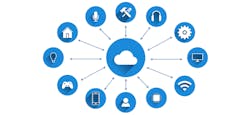Why electronic product design is ready for cloud computing
Every designer has a story that goes something like this. A big project is due on a Friday afternoon and everyone on the team rushes to meet the deadline. The design is complete, everyone is happy, and off it goes to manufacturing. Done and dusted, right? Well, not quite.
When Monday morning rolls around, you get a call to let you know that what you designed is DOA. Can't be built. That's because a key component you used in your design hasn't been available for five years—or, it's simply missing. Manufacturing is irritated. And it's on to the next iteration of the design you worked so hard to get out the door. In fact, the vast majority of designs today are put on hold as soon as they hit the manufacturing floor.
At a time when Alexa can turn on the lights, Waze can tell you how to avoid a traffic jam in real time, and Amazon can drop a package on your doorstep in a matter of hours, it seems a designer and manufacturer ought to be able to get it right the first time.
In truth, the electronic product design industry has been as conservative as health care and banking with regards to adopting new technologies that foster the easy exchange of real-time information and collaboration. This is particularly true when it comes to Cloud Computing. That's about to change. And that's a good thing.
So why now? As with other industries, then entrance of a new wave of millenials that expects connectivity and convenience will be partially responsible for the shift. But other more industry-specific factors are also at play.
The shrinking design cycle
Just in the last several years the typical design cycle has tightened considerably. I've seen a 10-cent device stop a manufacturer in its tracks—look no further than the tantalum capacitor, an essential component in pretty much every electronic device. Despite shortages that show no signs of abating, manufacturers no longer have the luxury of waiting. Designing a product could take two years, with multiple review and revise iterations. Today, that same cycle lasts closer to three months. Three months to complete a design cycle. In many ways, speed has become more important than cost.
The fading role of the PCB designer and growing design complexity
While printed circuit boards are at the core of innovation in electronics, the role of the PCB designer has diminished significantly over the last decade. Engineers have become master jugglers, taking on the responsibility of PCB design, administration and a host of other business tasks. This shift didn't happen overnight, but the great recession of 2008 sealed the fate of PCB design as a single position, as many PCB Designer were laid off and replaced by engineers. Today many engineers—who were never formally trained in PCB design—are far more intimately involved in PCB design; this is just as designs have become more and more complex. A new report by online news site Engineering.com found that 92% of queried engineers and designers believe product complexity has increased over the past five years.
The growing gap between design, manufacturing, and everything in-between
As electrical engineers have taken over a greater role in design, the disconnect between design and the manufacturing floor - both literally and philosophically—has widened significantly. When PCB designers were at the fore they were relatively connected with their counterparts on the manufacturing floor. That connection has been virtually lost in today's world.
This is one of the most significant changes to occur in recent years and one that has possibly the greatest impact on innovation.
The lack of communication and collaboration from design to manufacturing results in both parties lacking the necessary context to do their jobs, and common misunderstandings. Manufacturers do not always understand designers' true intents and complain that their designs are not buildable. Designers can't understand why their products can't be built the way they've designed them. Multiple re-spins ensue and products are delayed. Design simply lacks an understanding of—and connectivity to—manufacturing.
This disconnect is not limited to design and manufacturing. Globalization and consolidation has created new barriers to communication—it's considerably difficult to collaborate across the product development cycle, from design to components distributors and then to manufacturing. We are dispersed across disciplines, offices and geographies—and we are all working with different tools—making it challenging to communicate within disciplines as well as between disciplines. This comes as sourcing and purchasing are becoming more complicated.
More autonomy for end users
I mentioned the shift from cost to innovation speed earlier. For end users—the designers, distributors and machinists—this hasn't actually been a bad change. They have been given more control over the tools they use to do their jobs and how they use them than ever before. Designers have more flexibility— and more freedom—and they want tools that favor a better design experience over pure design horsepower.
So what can Cloud Computing offer? How can Cloud Computing better enable electronic product design to meet these challenges and to innovate better, faster and cheaper?
By its nature, Cloud Computing provides an open platform for organizing and sharing information across disciplines and domains. This allows all parties to understand intent and context during the entire product development cycle. With real-time information at hand, users can anticipate design errors and other problems before they occur, reducing re-spins and increasing time to market.
A look at the healthcare industry, arguably one of the slowest industries to embrace Cloud Computing, may also offer some real-life lessons. Health care organizations that have long been wary of operating on the Cloud are finding the benefits widespread—from operational efficiencies to better and real-time sharing of patient files to clinical trial research and directly in patient care.
Patients who may forget their medications are now reminded through Cloud-based services to take their pills, helping to address the $290 billion health care cost each year due to preventable hospital readmissions. Cloud technologies are enabling physicians to provide borderless care, sharing files and images with colleagues and patients. A company called EchoPixel offers interactive 3-D holograms that let doctors turn data from CT and MRI scans into 3-D images that can be accessed and manipulated and shared via the Cloud. The company says the technology has enabled surgeons to detect more congenital heart defects in 40 percent less time.
Innovation demands communication and collaboration. With the confluence of these trends, the electronic product design industry is poised to embrace cloud computing in the next couple of years and as a result, will see rapid advances in productivity and innovation.
Lawrence Romine is vice president of global marketing at Altium. A Naval Aviation veteran, He has nearly 20 years’ experience in the hi-tech industry, having held numerous engineering, sales, and marketing positions across the consumer electronics space, semiconductor, and EDA industries. Thirteen of those years have been working at Altium, where Romine has held nearly every position on offer.



